Study on Functional Effectiveness of Soil and Water Conservation Measures in Rubber Plantations on Hainan Island
Abstract
:1. Introduction
2. Materials and Methods
2.1. Study Area
2.2. Configuration of Runoff Plots
2.3. Data Collection
2.4. Correlation Analysis
2.5. Path Analysis
3. Result
3.1. Rainfall Characteristics
3.2. Impacts of SWCMs on Runoff
3.3. Impacts of SWCMs on Erosion
3.4. Correlation between Runoff, Erosion, and Rainfall Characteristic Factors
3.5. Quantifying the Contribution of Rainfall Factors to Runoff and Erosion
4. Discussion
4.1. Impact of SWCMs on Runoff and Erosion
4.2. Impact of Rainfall Characteristic Factors on Runoff and Erosion
5. Conclusions
Author Contributions
Funding
Data Availability Statement
Acknowledgments
Conflicts of Interest
References
- Wuepper, D.; Borrelli, P.; Finger, R. Countries and the global rate of soil erosion. Nat. Sustain. 2020, 3, 51–55. [Google Scholar] [CrossRef]
- Pandey, S.; Kumar, P.; Zlatic, M.; Nautiyal, R.; Panwar, V.P. Recent advances in assessment of soil erosion vulnerability in a watershed. Int. Soil Water Conser. Res. 2021, 9, 305–318. [Google Scholar] [CrossRef]
- Zambon, N.; Johannsen, L.L.; Strauss, P.; Dostal, T.; Zumr, D.; Cochrane, T.A.; Klik, A. Splash erosion affected by initial soil moisture and surface conditions under simulated rainfall. Catena 2021, 196, 104827. [Google Scholar] [CrossRef]
- Zhang, Y.; Qin, X.; Qiu, Q.; Yu, R.G.; Yao, Y.F.; Li, H.Q.; Shao, M.G.; Wei, X.R. Soil and water conservation measures reduce erosion but result in carbon and nitrogen accumulation of red soil in Southern China. Agric. Ecosyst. Environ. 2023, 346, 108346. [Google Scholar] [CrossRef]
- Lal, R. Soil erosion and the global carbon budget. Environ. Int. 2003, 29, 437–450. [Google Scholar] [CrossRef]
- Shin, J.; Kim, T.; Heo, J.; Lee, J. Spatial and temporal variations in rainfall erosivity and erosivity density in South Korea. Catena 2019, 176, 125–144. [Google Scholar] [CrossRef]
- Sharda, V.N.; Mandal, D.; Dogra, P. Prioritizing soil conservation measures based on water erosion risk and production and bio-energy losses in peninsular South Indian states. Catena 2021, 202, 105263. [Google Scholar] [CrossRef]
- Johannsen, L.L.; Schmalz, E.M.; Mitrovits, O.; Klik, A.; Smoliner, W.; Wang, S.P.; Strauss, P. An update of the spatial and temporal variability of rainfall erosivity(R-factor) for the main agricultural production zones of Austria. Catena 2022, 215, 106305. [Google Scholar] [CrossRef]
- Pawel, M.; Sylwia, S. Assessing monthly dynamics of agricultural soil erosion risk in Poland. Geoderma Reg. 2024, 39, e00864. [Google Scholar]
- Louzada, R.O.; Bergier, I.; Diniz, J.M.F.; Guerra, A.; Roque, F.O. Priority setting for restoration in surrounding savannic areas of the Brazilian Pantanal based on soil loss risk and agrarian structure. J. Environ. Manag. 2022, 323, 116219. [Google Scholar] [CrossRef]
- Shahab, A.S.; Malik, A.; Mohammad, R.N.; Mehrdad, G.M.; Mohammad, R.A.; Jan, F.A.; Hamid, M.; Nasrin, A.; Amir, H.G. Soil erosion in the United States: Present and future (2020–2050). Catena 2024, 242, 108074. [Google Scholar]
- China Soil and Water Conservation Bulletin (2023); Ministry of Water Resources of the PRC: Beijing, China, 2024.
- Shi, D.M.; Jiang, G.Y.; Peng, X.D.; Jin, H.F.; Jiang, N. Relationship between the periodicity of soil and water loss and erosion-sensitive periods based on temporal distributions of rainfall erosivity in the Three Gorges Reservoir Region, China. Catena 2021, 202, 105268. [Google Scholar] [CrossRef]
- Zhu, D.Y.; Xiong, K.N.; Xiao, H.; Gu, X.P. Variation characteristics of rainfall erosivity in Guizhou Province and the correlation with the El Niño Southern Oscillation. Sci. Total Environ. 2019, 691, 835–847. [Google Scholar] [CrossRef] [PubMed]
- Gu, X.Z.; Ye, L.; Xin, Q.; Zhang, C.; Zeng, F.Z.; Nerantzaki, S.D.; Papalexiou, S.M. Extreme Precipitation in China: A Review on Statistical Methods and Applications. Adv. Water Resour. 2022, 163, 104144. [Google Scholar] [CrossRef]
- Lu, X.D.; Chen, J.D.; Guo, J.C.; Qi, S. Variation characteristics of rainfall erosivity in tropical China and its impact on river sediment load. Front. Environ. Sci. 2023, 11, 1084503. [Google Scholar] [CrossRef]
- Zhu, X.A.; Yuan, X.; Lu, E.F.; Yang, B.; Wang, H.F.; Du, Y.Y.; Singh, A.K.; Liu, W.J. Soil splash erosion: An overlooked issue for sustainable rubber plantation in the tropical region of China. Int. Soil Water Conser. Res. 2023, 11, 30–42. [Google Scholar] [CrossRef]
- Chen, J.; Xiao, H.B.; Li, Z.W.; Liu, C.; Ning, K.; Tang, C.J. How effective are soil and water conservation measures (SWCMs) in reducing soil and water losses in the red soil hilly region of China? A meta-analysis of field plot data. Sci. Total Environ. 2020, 735, 139517. [Google Scholar] [CrossRef]
- Zhang, J.L.; Zhou, L.L.; Ma, R.M.; Jia, Y.F.; Yang, F.; Zhou, H.Y.; Cao, X.Y. Influence of soil moisture content and soil and water conservation measures on time to runoff initiation under different rainfall intensities. Catena 2019, 182, 104172. [Google Scholar] [CrossRef]
- Luo, J.; Zhou, X.L.; Rubinato, M.; Li, G.J.; Tian, Y.X.; Zhou, J.X. Impact of Multiple Vegetation Covers on Surface Runo and Sediment Yield in the Small Basin of Nverzhai, Hunan Province, China. Forests 2020, 11, 329. [Google Scholar] [CrossRef]
- Liu, Y.H.; Han, J.Q.; Liu, Y.H.; Zhang, S.Y.; Min, L.X.; Liu, B.Y.; Jiao, J.Y.; Zhang, L. Effects of soil and water conservation measures of slope surfaces on flood peaks of small watersheds: A study based on three extreme rainstorm events in northern China. Catena 2023, 232, 107432. [Google Scholar] [CrossRef]
- Hu, W.; Xu, J.Z.; Li, J.Y.; Zhang, X.Y. The effect of soil and water conservation measures on soil organic carbon in a typical small watershed in the Mollisol region of Northeast China. Catena 2022, 208, 105744. [Google Scholar] [CrossRef]
- Duan, G.H.; Wen, Z.M.; Xue, W.; Bu, Y.K.; Lu, J.X.; Wen, B.J.; Wang, B.h.; Chen, S.H. Agents affecting the plant functional traits in national soil and water conservation demonstration park (China). Plants 2022, 11, 2891. [Google Scholar] [CrossRef] [PubMed]
- Duan, G.H.; Zhou, R.L.; Wang, L.C.; Zheng, C.; Liu, Y.D.; Chai, X.H.; Zhou, C.F.; Wen, Z.M. Effects of different soil and water conservation measures on plant diversity and productivity in Loess Plateau. J. Environ. Manag. 2023, 348, 119330. [Google Scholar] [CrossRef]
- Hu, Y.T.; Zhang, F.; Luo, Z.Z.; Badreldin, N.; Benoy, G.; Xing, Z.S. Soil and water conservation effects of different types of vegetation cover on runoff and erosion driven by climate and underlying surface conditions. Catena 2023, 231, 107347. [Google Scholar] [CrossRef]
- Gen, S.W.; Wu, Z.X.; Yang, C. Water vapor flux exchange of rubber forest stand in Hainan Danzhou and its response to environmental factors. J. North. For. Univ. 2021, 36, 77–85, (In Chinese with English Abstract). [Google Scholar]
- Duan, J.; Liu, Y.J.; Yang, J.; Tang, C.J.; Shi, Z.H. Role of groundcover management in controlling soil erosion under extreme rainfall in citrus orchards of southern China. J. Hydro 2020, 582, 124290. [Google Scholar] [CrossRef]
- Shao, W.Y.; Wang, Q.Z.; Guan, Q.Y.; Luo, H.P.; Ma, Y.R.; Zhang, J. Distribution of soil available nutrients and their response to environmental factors based on path analysis model in arid and semi-arid area of northwest China. Sci. Total Environ. 2023, 827, 154254. [Google Scholar] [CrossRef] [PubMed]
- Huo, J.Y.; Liu, C.J.; Yu, X.X.; Jia, G.D.; Chen, L.H. Effects of watershed char and climate variables on annual runoff in different climatic zones in China. Sci. Total Environ. 2021, 754, 142157. [Google Scholar] [CrossRef]
- Garson, D. Path Analysis; North Carolina State University: Raleigh, NC, USA, 2008. [Google Scholar]
- Wu, B.C.; Qi, S.; Guo, J.C. Effects of forestland spatial pattern and micro-topography on surface runoff in a mountainous area of southwestern China. Trans. Chin. Soc. Agric. Eng. 2021, 37, 108–116, (In Chinese with English Abstract). [Google Scholar]
- Chen, D.; Wei, W.; Chen, L.D. Effects of terracing practices on water erosion control in China: A meta-analysis. Earth-Sci. Rev. 2017, 173, 109–121. [Google Scholar] [CrossRef]
- Feng, J.; Wei, W.; Pan, D.L. Effects of rainfall and terracing-vegetation combinations on water erosion in a loess hilly area, China. J. Environ. Manag. 2020, 261, 110247. [Google Scholar] [CrossRef] [PubMed]
- Fernandes, A.C.; Gontijo, L.M. Terracing field slopes can concurrently mitigate soil erosion and promote sustainable pest management. J. Environ. Manag. 2020, 269, 110801. [Google Scholar] [CrossRef]
- Gu, C.; Mu, X.; Gao, P.; Zhao, G.J.; Sun, W.Y.; Tan, X.J. Distinguishing the effects of vegetation restoration on runoff and sediment generation on simulated rainfall on the hillslopes of the loess plateau of China. Plant Soil 2020, 447, 393–412. [Google Scholar] [CrossRef]
- Yan, Y.; Zhen, H.; Zhai, X.Y.; Li, J.Y.; Hu, W.; Ding, C.; Qi, Z.; Qiao, B.L.; Li, H.; Liu, X.B.; et al. The role of vegetation on earth bunds in mitigating soil erosion in Mollisols region of Northeast China. Catena 2021, 196, 104927. [Google Scholar] [CrossRef]
- Bai, R.H.; Wang, X.Z.; Li, J.W.; Yang, F.; Shangguan, Z.P.; Deng, L. The impact of vegetation reconstruction on soil erosion in the Loess plateau. J. Environ. Manag. 2024, 363, 121382. [Google Scholar] [CrossRef]
- Carretta, L.; Tarolli, P.; Cardinali, A.; Nasta, P.; Romano, N.; Masin, R. Evaluation of runoff and soil erosion under conventional tillage and no-till management: A case study in northeast Italy. Catena 2021, 197, 104972. [Google Scholar] [CrossRef]
- Li, X.H.; Yang, J.; Zhao, C.Y.; Wang, B. Runoff and sediment from orchard terraces in southeastern China. Land Degrad. Dev. 2014, 25, 184–192. [Google Scholar] [CrossRef]
- Jiang, C.; Zhang, H.Y.; Wang, X.C.; Feng, Y.Q.; Labzovskii, L. Challenging the land degradation in China’s Loess Plateau: Benefits, limitations, sustainability, and adaptive strategies of soil and water conservation. Ecol. Eng. 2019, 127, 135–150. [Google Scholar] [CrossRef]
- Sun, M.; Wang, Z.; Li, Z.; Xu, X.L.; Qin, L.; Song, T. Temporal variations in rainfall, runoff and sediment yield in small karst watersheds. Catena 2023, 231, 107292. [Google Scholar] [CrossRef]
- Fan, D.; Yu, X.; Jia, G.; Wang, H. Characteristics of soil and water loss and its influencing factors on slope scale in rocky mountain area of Beijing. Sci. Soil Water Conserv. 2014, 12, 24–28, (In Chinese with English Abstract). [Google Scholar]
- Zhao, J.L.; Yang, Z.Q.; Govers, G. Soil and water conservation measures reduce soil and water losses in China but not down to background levels: Evidence from erosion plot data. Geoderma 2019, 337, 729–741. [Google Scholar] [CrossRef]
- Zhao, L.S.; Fang, Q.; Hou, R.; Wu, F.Q. Effect of rainfall intensity and duration on soil erosion on slopes with different microrelief patterns. Geoderma 2021, 396, 115085. [Google Scholar] [CrossRef]
- Zhao, J.L.; Wang, Z.G.; Dong, Y.F.; Yang, Z.Q.; Govers, G. How soil erosion and runoff are related to land use, topography and annual precipitation: Insights from a meta-analysis of erosion plots in China. Sci. Total Environ. 2022, 802, 149665. [Google Scholar] [CrossRef] [PubMed]

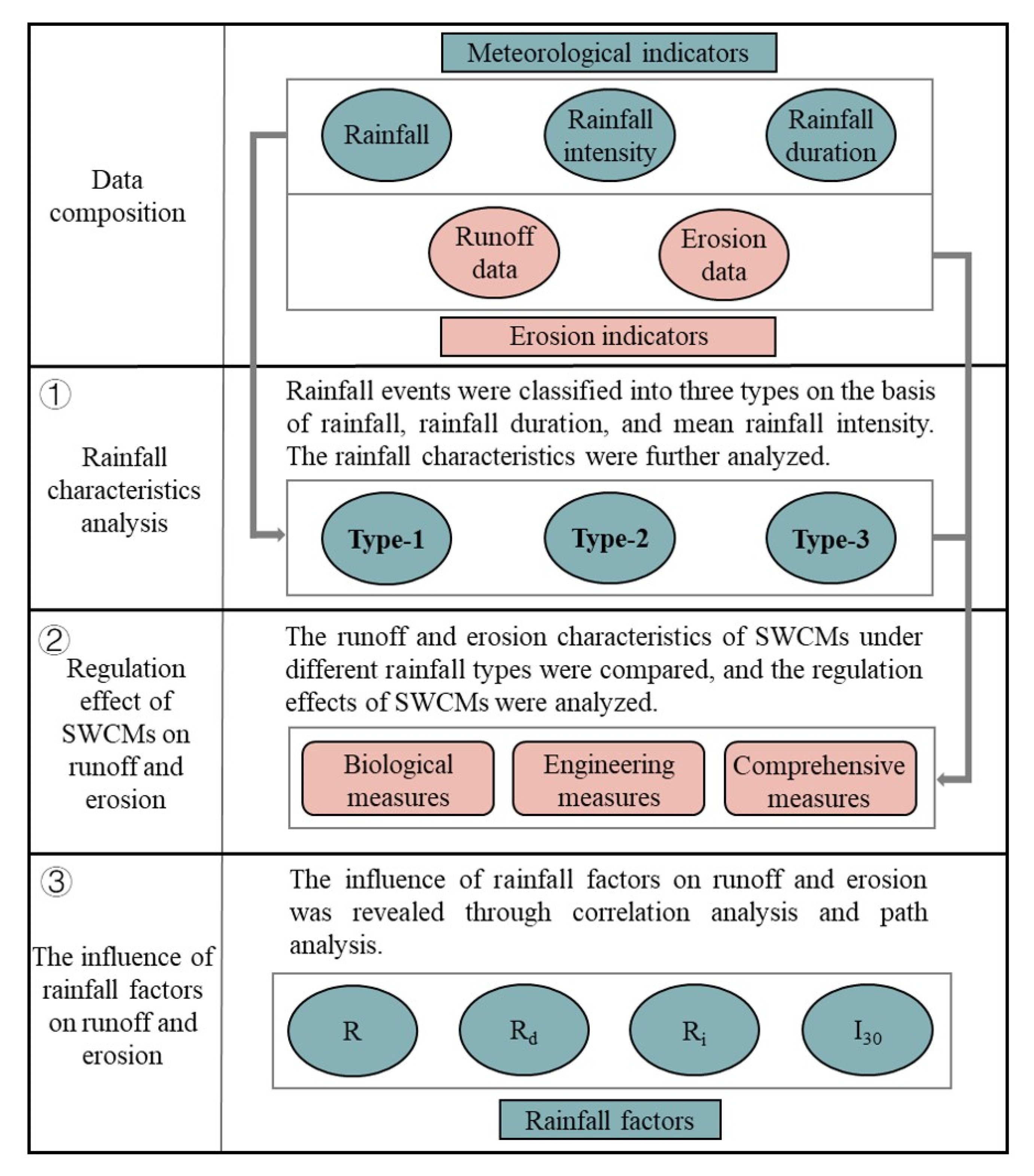
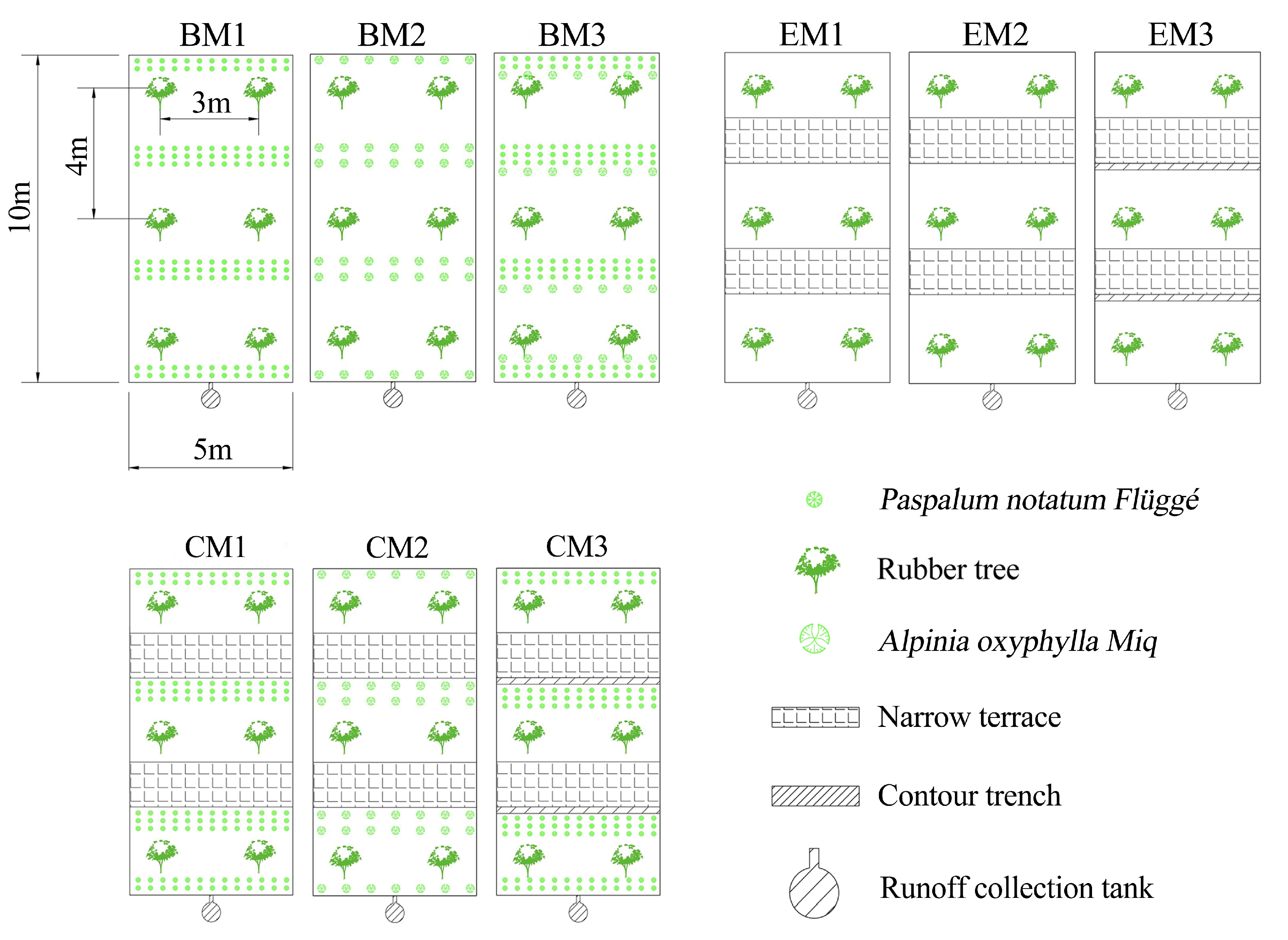
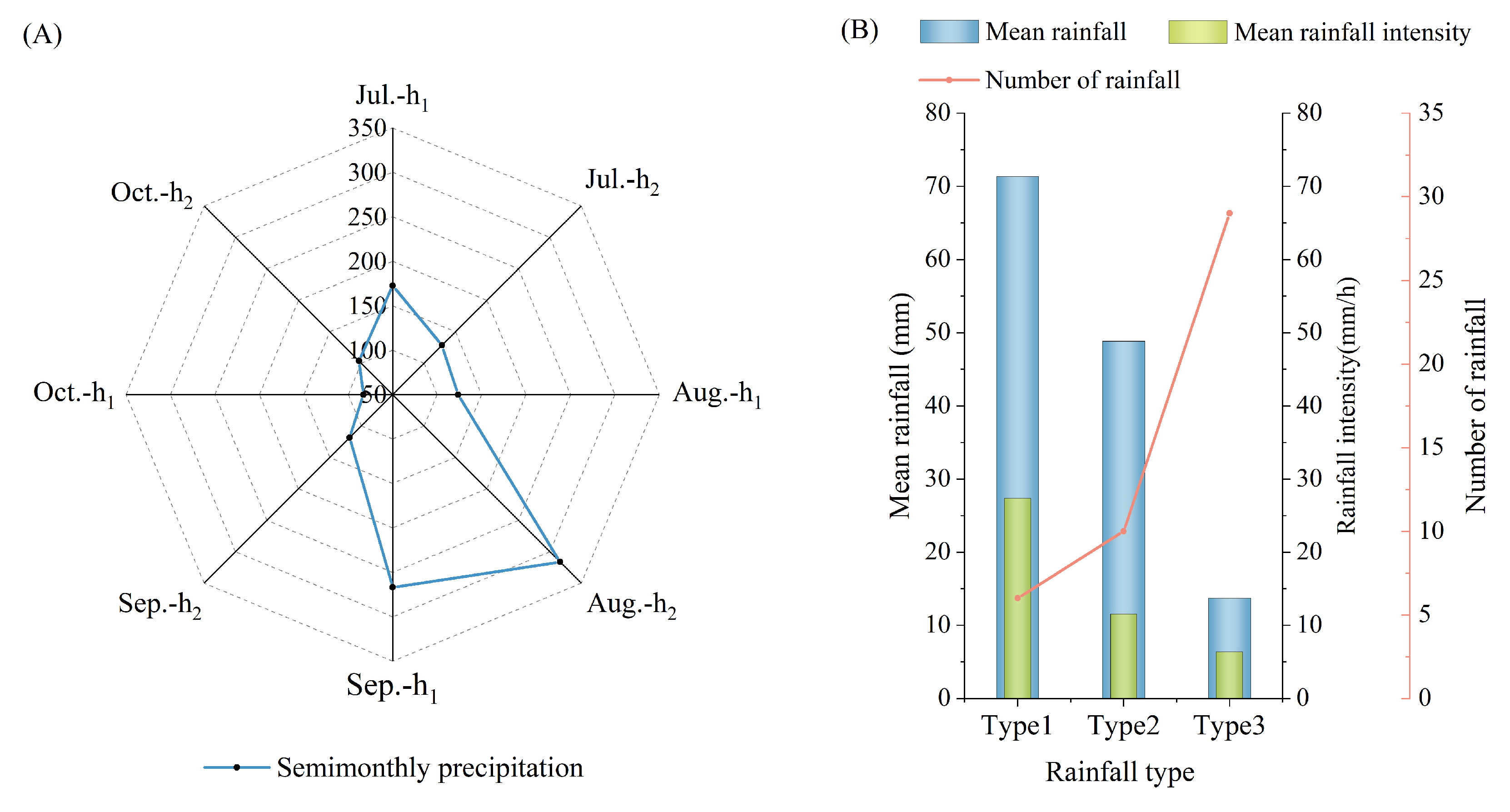
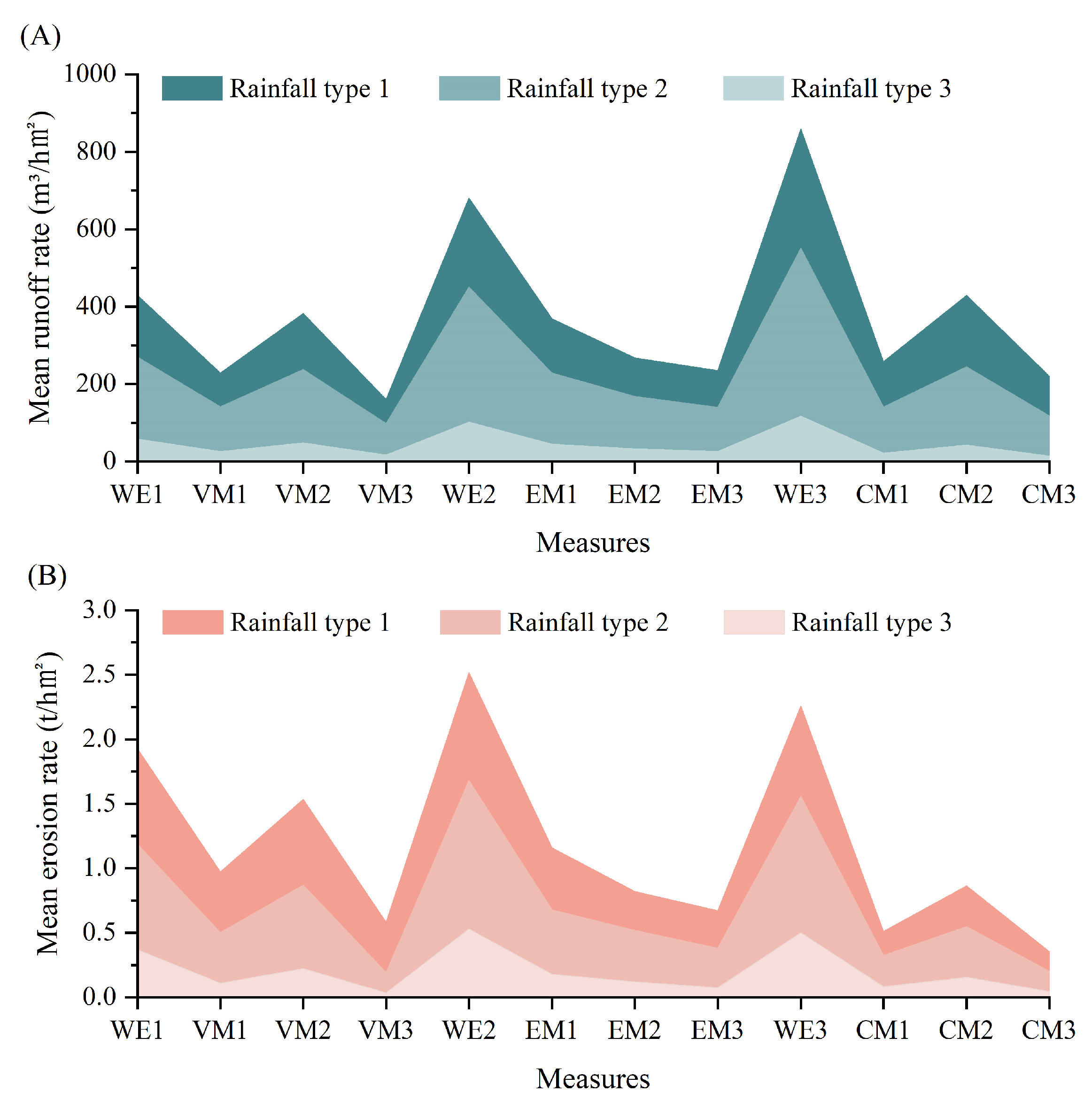
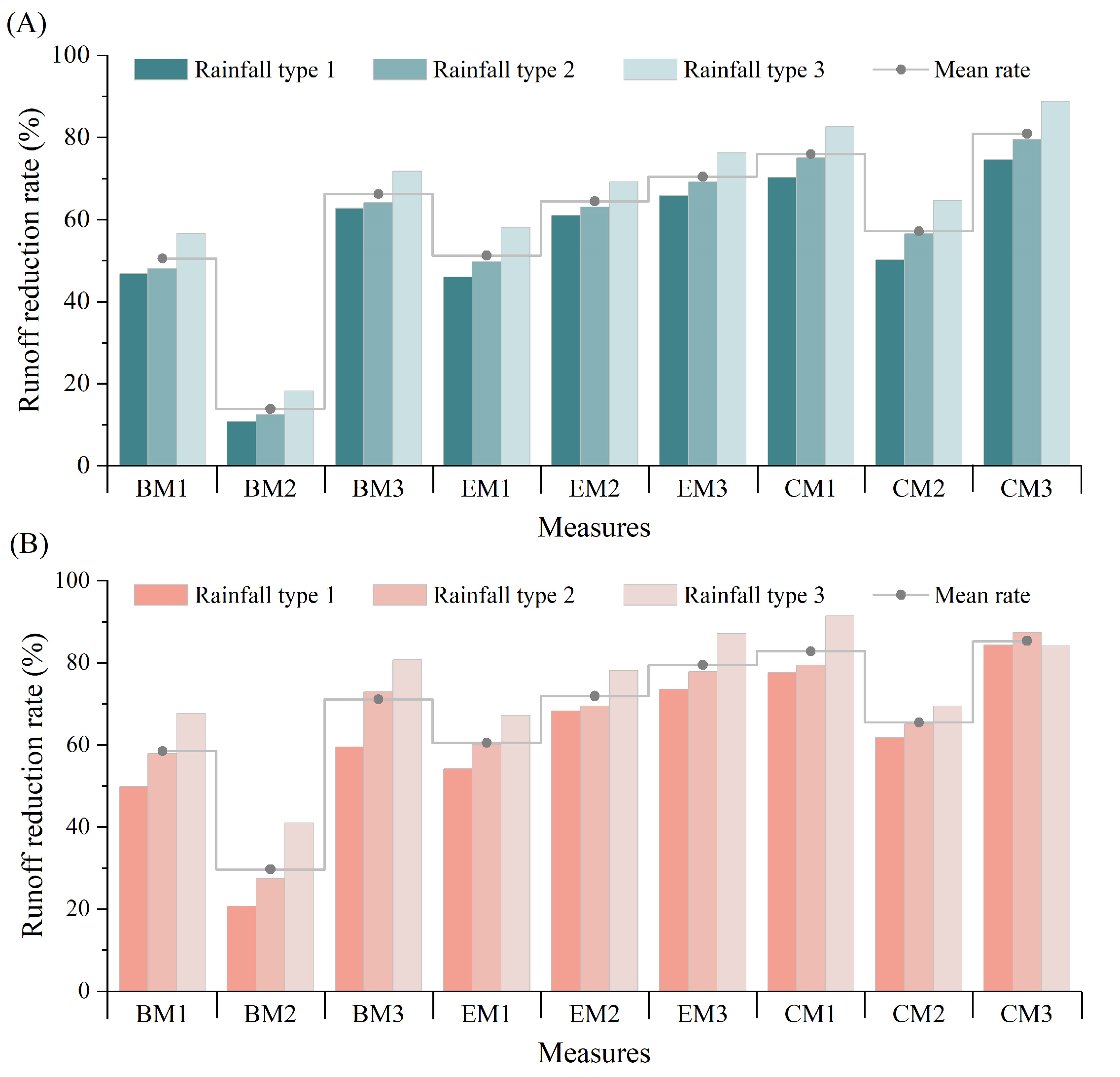
| Plot Number | Measure | Slope (°) | Plot Size (m × m) | Planting Spacing (m × m) | Number of Plants in Plot |
|---|---|---|---|---|---|
| D1 | Weeding 1 | 12° | 10 × 5 | 4 × 3 | 6 |
| D2 | Biological measure 1 | 12° | 10 × 5 | 4 × 3 | 6 |
| D3 | Biological measure 2 | 12° | 10 × 5 | 4 × 3 | 6 |
| D4 | Biological measure 3 | 12° | 10 × 5 | 4 × 3 | 6 |
| D5 | Weeding 2 | 23° | 10 × 5 | 4 × 3 | 6 |
| D6 | Engineering measure 1 | 23° | 10 × 5 | 4 × 3 | 6 |
| D7 | Engineering measure 2 | 23° | 10 × 5 | 4 × 3 | 6 |
| D8 | Engineering measure 3 | 23° | 10 × 5 | 4 × 3 | 6 |
| D9 | Weeding 3 | 30° | 10 × 5 | 4 × 3 | 6 |
| D10 | Comprehensive measure 1 | 30° | 10 × 5 | 4 × 3 | 6 |
| D11 | Comprehensive measure 2 | 30° | 10 × 5 | 4 × 3 | 6 |
| D12 | Comprehensive measure 3 | 30° | 10 × 5 | 4 × 3 | 6 |
| Measures | Runoff Rate | Erosion Rate | ||||||
|---|---|---|---|---|---|---|---|---|
| R | Rd | Ri | I30 | R | Rd | Ri | I30 | |
| BM1 | 0.791 ** | 0.191 | 0.381 | 0.556 ** | 0.542 * | 0.152 | 0.363 | 0.697 ** |
| BM2 | 0.683 ** | 0.198 | 0.296 | 0.570 ** | 0.361 * | 0.171 | 0.256 | 0.781 ** |
| BM3 | 0.668 ** | 0.186 | 0.410 | 0.701 ** | 0.350 * | 0.064 | 0.267 | 0.807 ** |
| EM1 | 0.635 ** | 0.207 | 0.391 | 0.594 ** | 0.308 * | 0.188 | 0.463 | 0.793 ** |
| EM2 | 0.722 ** | 0.197 | 0.356 | 0.603 ** | 0.391 * | 0.198 | 0.144 | 0.750 ** |
| EM3 | 0.759 ** | 0.205 | 0.403 | 0.680 ** | 0.399 * | 0.140 | 0.276 | 0.809 ** |
| CM1 | 0.713 ** | 0.152 | 0.380 | 0.520 ** | 0.452 * | 0.185 | 0.355 | 0.766 ** |
| CM2 | 0.606 ** | 0.180 | 0.302 | 0.500 ** | 0.407 * | 0.217 | 0.102 | 0.698 ** |
| CM3 | 0.614 ** | 0.177 | 0.299 | 0.695 ** | 0.338 * | 0.181 | 0.266 | 0.804 ** |
| Measures | Rainfall Factors | Pd | Pid | Cd | Cid | Total Contribution | |||||||||
|---|---|---|---|---|---|---|---|---|---|---|---|---|---|---|---|
| R | Rd | Ri | I30 | Total | R | Rd | Ri | I30 | Total | ||||||
| Runoff rate | BM1 | R | 0.76 | 57.76 | 57.76 | ||||||||||
| Rd | 0.11 | 0.22 | −0.13 | −0.05 | 0.04 | 1.21 | 4.84 | 0 | −2.86 | −1.1 | 0.88 | 2.09 | |||
| Ri | 0.34 | 11.56 | 11.56 | ||||||||||||
| I30 | 0.57 | 32.49 | 32.49 | ||||||||||||
| BM2 | R | 0.68 | 46.24 | 46.24 | |||||||||||
| Rd | 0.08 | 0.24 | −0.11 | −0.06 | 0.07 | 0.64 | 3.84 | 0 | −1.76 | −0.96 | 1.12 | 1.76 | |||
| Ri | 0.22 | 4.84 | 4.84 | ||||||||||||
| I30 | 0.58 | 33.64 | 33.64 | ||||||||||||
| BM3 | R | 0.62 | 38.44 | 38.44 | |||||||||||
| Rd | 0.13 | 0.19 | −0.15 | −0.04 | 0 | 1.69 | 4.94 | 0 | −3.9 | −1.04 | 0 | 1.69 | |||
| Ri | 0.53 | 28.09 | 28.09 | ||||||||||||
| I30 | 0.59 | 34.81 | 34.81 | ||||||||||||
| Erosion rate | BM1 | R | 0.49 | 0.12 | 0.12 | 24.01 | 11.76 | 11.76 | 35.77 | ||||||
| Rd | 0.11 | 1.21 | 1.21 | ||||||||||||
| Ri | 0.19 | 3.61 | 3.61 | ||||||||||||
| I30 | 0.51 | 0.18 | 0.18 | 26.01 | 18.36 | 18.36 | 44.37 | ||||||||
| BM2 | R | 0.37 | 0.1 | 0.1 | 13.69 | 7.4 | 7.4 | 21.09 | |||||||
| Rd | 0.1 | 1 | 1 | ||||||||||||
| Ri | 0.19 | 3.61 | 3.61 | ||||||||||||
| I30 | 0.64 | 0.21 | 0.21 | 40.96 | 26.88 | 26.88 | 67.84 | ||||||||
| BM3 | R | 0.35 | 0.11 | 0.11 | 12.25 | 7.7 | 7.7 | 19.95 | |||||||
| Rd | 0.08 | 0.64 | 0.64 | ||||||||||||
| Ri | 0.12 | 1.44 | 1.44 | ||||||||||||
| I30 | 0.54 | 0.29 | 0.29 | 29.16 | 31.32 | 31.32 | 60.48 | ||||||||
| Measures | Rainfall Factors | Pd | Pid | Cd | Cid | Total Contribution | |||||||||
|---|---|---|---|---|---|---|---|---|---|---|---|---|---|---|---|
| R | Rd | Ri | I30 | Total | R | Rd | Ri | I30 | Total | ||||||
| Runoff rate | EM1 | R | 0.61 | 37.21 | 37.21 | ||||||||||
| Rd | 0.08 | 0.25 | −0.12 | −0.05 | 0.08 | 0.64 | 4 | 0 | −1.92 | −0.8 | 1.28 | 1.92 | |||
| Ri | 0.29 | 8.41 | 8.41 | ||||||||||||
| I30 | 0.63 | 39.69 | 39.69 | ||||||||||||
| EM2 | R | 0.74 | 54.76 | 54.76 | |||||||||||
| Rd | 0.06 | 0.23 | −0.12 | −0.04 | 0.07 | 0.36 | 2.76 | 0 | −1.44 | −0.48 | 0.84 | 1.2 | |||
| Ri | 0.27 | 7.29 | 7.29 | ||||||||||||
| I30 | 0.68 | 46.24 | 46.24 | ||||||||||||
| EM3 | R | 0.75 | 56.25 | 56.25 | |||||||||||
| Rd | 0.11 | 0.23 | −0.1 | −0.03 | 0.1 | 1.21 | 5.06 | 0 | −2.2 | −0.66 | 2.2 | 3.41 | |||
| Ri | 0.39 | 15.21 | 15.21 | ||||||||||||
| I30 | 0.71 | 50.41 | 50.41 | ||||||||||||
| Erosion rate | EM1 | R | 0.3 | 0.09 | 0.09 | 9 | 5.4 | 5.4 | 14.4 | ||||||
| Rd | 0.1 | 1 | 1 | ||||||||||||
| Ri | 0.31 | 9.61 | 9.61 | ||||||||||||
| I30 | 0.49 | 0.13 | 0.13 | 24.01 | 12.74 | 12.74 | 36.75 | ||||||||
| EM2 | R | 0.39 | 0.09 | 0.09 | 15.21 | 7.02 | 7.02 | 22.23 | |||||||
| Rd | 0.12 | 1.44 | 1.44 | ||||||||||||
| Ri | 0.09 | 0.81 | 0.81 | ||||||||||||
| I30 | 0.61 | 0.24 | 0.24 | 37.21 | 29.28 | 29.28 | 66.49 | ||||||||
| EM3 | R | 0.31 | 0.07 | 0.07 | 9.61 | 4.34 | 4.34 | 13.95 | |||||||
| Rd | 0.09 | 0.81 | 0.81 | ||||||||||||
| Ri | 0.13 | 1.69 | 1.69 | ||||||||||||
| I30 | 0.58 | 0.22 | 0.22 | 33.64 | 25.52 | 25.52 | 59.16 | ||||||||
| Measures | Rainfall Factors | Pd | Pid | Cd | Cid | Total Contribution | |||||||||
|---|---|---|---|---|---|---|---|---|---|---|---|---|---|---|---|
| R | Rd | Ri | I30 | Total | R | Rd | Ri | I30 | Total | ||||||
| Runoff rate | CM1 | R | 0.74 | 54.76 | 54.76 | ||||||||||
| Rd | 0.09 | 0.16 | −0.12 | −0.08 | −0.04 | 0.81 | 2.88 | 0 | −2.16 | −1.44 | −0.72 | 0.09 | |||
| Ri | 0.26 | 6.76 | 6.76 | ||||||||||||
| I30 | 0.51 | 26.01 | 26.01 | ||||||||||||
| CM2 | R | 0.66 | 43.56 | 43.56 | |||||||||||
| Rd | 0.06 | 0.19 | −0.14 | −0.09 | −0.04 | 0.36 | 2.28 | 0 | −1.68 | −1.08 | −0.48 | −0.12 | |||
| Ri | 0.1 | 1 | 1 | ||||||||||||
| I30 | 0.47 | 22.09 | 22.09 | ||||||||||||
| CM3 | R | 0.63 | 39.69 | 39.69 | |||||||||||
| Rd | 0.11 | 0.18 | −0.14 | −0.06 | −0.02 | 1.21 | 3.96 | 0 | −3.08 | −1.32 | −0.44 | 0.77 | |||
| Ri | 0.13 | 1.69 | 1.69 | ||||||||||||
| I30 | 0.65 | 42.25 | 42.25 | ||||||||||||
| Erosion rate | CM1 | R | 0.4 | 0.21 | 0.21 | 16 | 16.8 | 16.8 | 32.8 | ||||||
| Rd | 0.08 | 0.15 | 0.15 | 0.64 | 0.64 | ||||||||||
| Ri | 0.13 | 1.69 | 1.69 | ||||||||||||
| I30 | 0.6 | 0.24 | 0.24 | 36 | 28.8 | 28.8 | 64.8 | ||||||||
| CM2 | R | 0.33 | 0.07 | 0.07 | 10.89 | 4.62 | 4.62 | 15.51 | |||||||
| Rd | 0.08 | 0.64 | 0.64 | ||||||||||||
| Ri | 0.04 | 0.16 | 0.16 | ||||||||||||
| I30 | 0.59 | 0.28 | 0.28 | 34.81 | 33.04 | 33.04 | 67.85 | ||||||||
| CM3 | R | 0.28 | 0.08 | 0.08 | 7.84 | 4.48 | 4.48 | 12.32 | |||||||
| Rd | 0.06 | 0.36 | 0.36 | ||||||||||||
| Ri | 0.17 | 2.89 | 2.89 | ||||||||||||
| I30 | 0.62 | 0.33 | 0.33 | 38.44 | 40.92 | 40.92 | 79.36 | ||||||||
Disclaimer/Publisher’s Note: The statements, opinions and data contained in all publications are solely those of the individual author(s) and contributor(s) and not of MDPI and/or the editor(s). MDPI and/or the editor(s) disclaim responsibility for any injury to people or property resulting from any ideas, methods, instructions or products referred to in the content. |
© 2024 by the authors. Licensee MDPI, Basel, Switzerland. This article is an open access article distributed under the terms and conditions of the Creative Commons Attribution (CC BY) license (https://creativecommons.org/licenses/by/4.0/).
Share and Cite
Lu, X.; Guo, J.; Chen, J.; Wu, H.; Zuo, Q.; Chen, Y.; Lai, J.; Liu, S.; Wang, M.; Zhang, P.; et al. Study on Functional Effectiveness of Soil and Water Conservation Measures in Rubber Plantations on Hainan Island. Forests 2024, 15, 1793. https://doi.org/10.3390/f15101793
Lu X, Guo J, Chen J, Wu H, Zuo Q, Chen Y, Lai J, Liu S, Wang M, Zhang P, et al. Study on Functional Effectiveness of Soil and Water Conservation Measures in Rubber Plantations on Hainan Island. Forests. 2024; 15(10):1793. https://doi.org/10.3390/f15101793
Chicago/Turabian StyleLu, Xudong, Jianchao Guo, Jiadong Chen, Hui Wu, Qin Zuo, Yizhuang Chen, Jinlin Lai, Shaodong Liu, Maoyuan Wang, Peng Zhang, and et al. 2024. "Study on Functional Effectiveness of Soil and Water Conservation Measures in Rubber Plantations on Hainan Island" Forests 15, no. 10: 1793. https://doi.org/10.3390/f15101793
APA StyleLu, X., Guo, J., Chen, J., Wu, H., Zuo, Q., Chen, Y., Lai, J., Liu, S., Wang, M., Zhang, P., & Qi, S. (2024). Study on Functional Effectiveness of Soil and Water Conservation Measures in Rubber Plantations on Hainan Island. Forests, 15(10), 1793. https://doi.org/10.3390/f15101793





